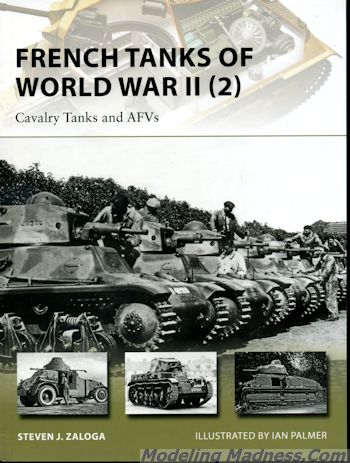 This
next title in Osprey's New Vanguard series covers French cavalry and AFVs of
WWII. I somehow missed volume 1 which covered the larger tanks. Anyway, when
WWII started, the French had a rather good tank force. However, French tank
production suffered from the same sort of issues that held back its aviation
industry; an inability to get all the bits needed to make the equipment
operational. It seems that French tank turrets were made by the government
rather than the maker of the tank and dozens of new production tanks sat in
depots awaiting turrets, while the Germans overran the French Army.
This
next title in Osprey's New Vanguard series covers French cavalry and AFVs of
WWII. I somehow missed volume 1 which covered the larger tanks. Anyway, when
WWII started, the French had a rather good tank force. However, French tank
production suffered from the same sort of issues that held back its aviation
industry; an inability to get all the bits needed to make the equipment
operational. It seems that French tank turrets were made by the government
rather than the maker of the tank and dozens of new production tanks sat in
depots awaiting turrets, while the Germans overran the French Army.
The French were probably some of the more forward thinking of nations
when it came to tanks of any type. In the US, it wasn't until the war in Europe
was underway that any serious effort was put into tanks. This was due as much to
the reticence of cavalry generals to go mechanized. This does not seem to have
been an issue with the French. What was an issue was finding the right vehicle.
The French military went through a considerable number of light tanks
and armored cars and half tracks in search of the perfect cavalry or
reconnaissance vehicle. Most armored cars had poor off road performance while
most tracked vehicles were too slow.
Another difficulty was that French tanks had one man turrets. This meant
that the tank commander had to load the gun, aim the gun, fire the gun, talk on
the radio and keep track of where other tanks were in his unit as well as where
the enemy might be all at the same time. The word 'overload' seems to be
appropriate. Not that the Germans were not in the same position when it came to
the Panzer I, but that was only one vehicle when the situation with the French
designs was endemic.
Fortunately, some of their armored cars had two man turrets and later
designed French tanks were getting around to multiple people in the turret, but
few of those actually made it into combat. By and large, the French had pretty
good tanks, much better than most think. What they did not have was good
tactical commanders. French armored unit commanders were stuck into a playbook
mentality that did not allow for initiative, something that was taught to German
commanders. When something did not go according to plan, the French were at a
major disadvantage and that showed in their battle performance.
This book covers the early initiatives into mechanized cavalry as well
as the various tanks used. This includes various Renault tanks, the Souma S 35,
the Hotchkiss H 35 and H39 as well as the Panhard AMD 35. A goodly portion of
the book covers the performance of French units during the 1940 invasion and is
followed by French use of armored tanks after the 1940 Armistice that includes
use in the Levant and Indo-China. It also covers use during the Allied invasion
in November 1942. All of this is accompanied by superb period photos and the
excellent art work of Ian Palmer. In all, it makes for a great primer on French
cavalry tanks and AFVs. A book that I very much enjoyed reading and from which I
learned a lot. Highly recommended.
July 2014
For more on the complete line of Osprey books,
visit www.ospreypublishing.com. In the US, it is
Osprey Direct at 44-02 23rd St, Suite 219, Long Island City, NY 11101., where you can
get a catalogue of available books.
If you would like your product reviewed fairly and
fairly quickly, please
contact
the editor or see other details in the
Note to
Contributors.
 This
next title in Osprey's New Vanguard series covers French cavalry and AFVs of
WWII. I somehow missed volume 1 which covered the larger tanks. Anyway, when
WWII started, the French had a rather good tank force. However, French tank
production suffered from the same sort of issues that held back its aviation
industry; an inability to get all the bits needed to make the equipment
operational. It seems that French tank turrets were made by the government
rather than the maker of the tank and dozens of new production tanks sat in
depots awaiting turrets, while the Germans overran the French Army.
This
next title in Osprey's New Vanguard series covers French cavalry and AFVs of
WWII. I somehow missed volume 1 which covered the larger tanks. Anyway, when
WWII started, the French had a rather good tank force. However, French tank
production suffered from the same sort of issues that held back its aviation
industry; an inability to get all the bits needed to make the equipment
operational. It seems that French tank turrets were made by the government
rather than the maker of the tank and dozens of new production tanks sat in
depots awaiting turrets, while the Germans overran the French Army.